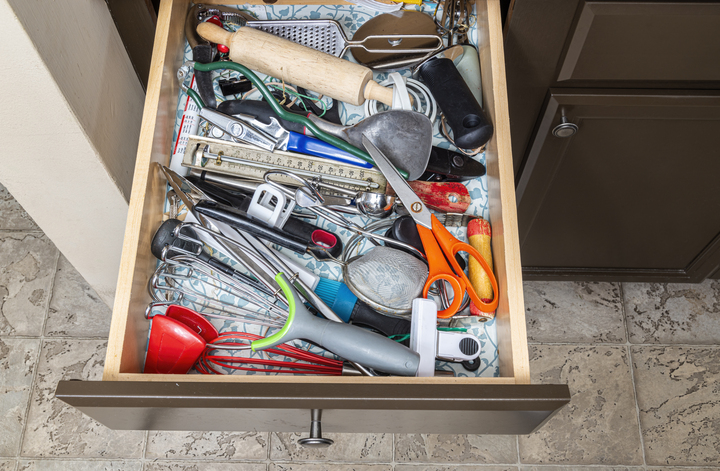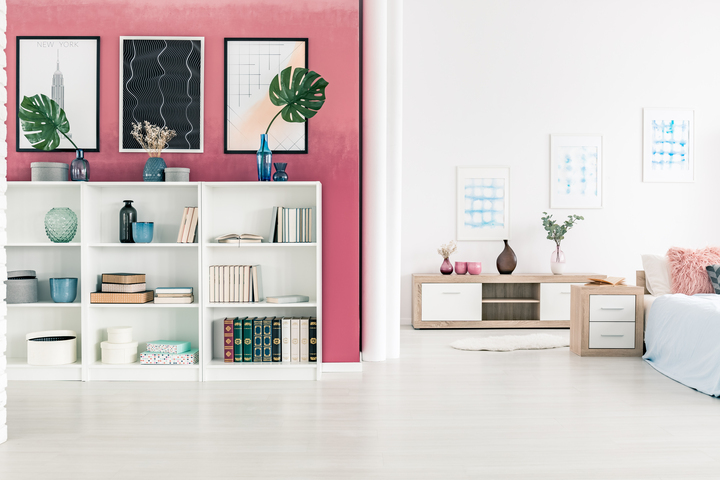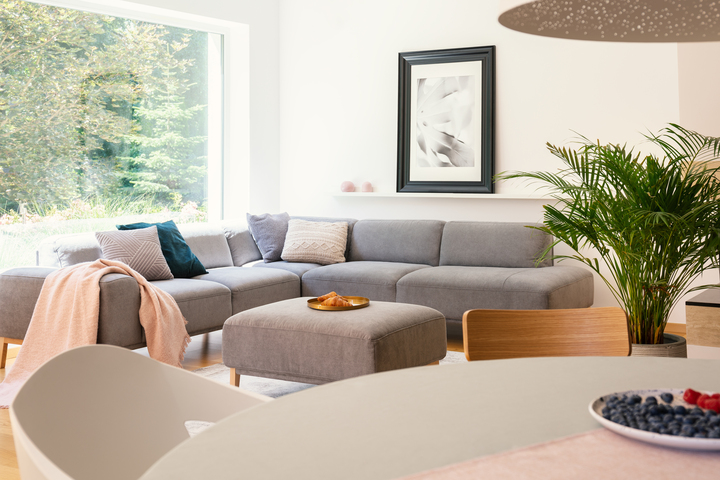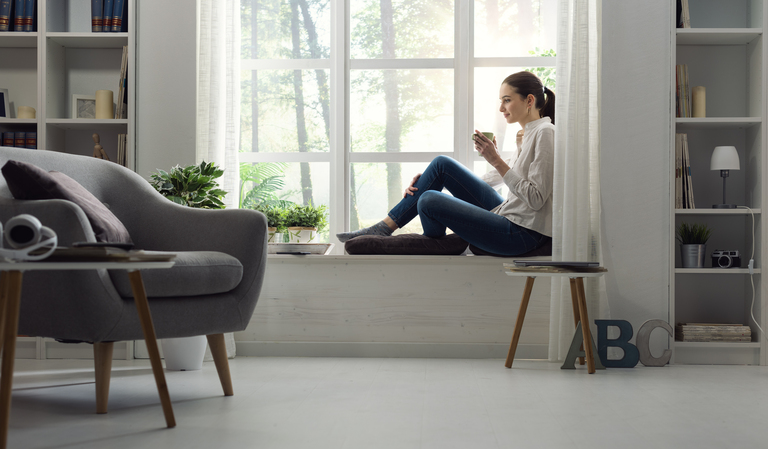Do you dream about a home where you feel serene and in which you can invite your family and friends? You know decluttering will help, but that thing is a bit scary. You’ve heard about projects going south and don’t want that for your home. Fear not! Follow these 10 rules for decluttering, and you’ll keep control over your projects and avoid arguments with your family!
You need a decluttering plan
Knowing where you go is crucial in this process. It will lower the overwhelm you could feel at the beginning and help you stay motivated until the end. You’ll also be able to delegate tasks and stay realistic about the work at hand.
To create your plan, start by listing your house’s rooms. For each, define the different areas. For example, in your bedroom, you may have your closet, a dresser, the nightstands, the storage under the bed, your catch-all chair… For each zone, guess how long you’ll need to sort everything. We often have more than we think, so give yourself extra time!
The next step is to decide when you’ll declutter. Will it be a quick daily habit? Or do you prefer to dedicate one day monthly to this project? Do you have a deadline to meet? Based on the previous elements, you’ll choose where to start and finish your decluttering plan by sorting the following tasks.
Last, decide how you’ll deal with the items you declutter. Will you donate them, and where? Will you sell some? What will be the practical steps to do so? You’ll get a better insight into this post-decluttering critical task.
Get a decluttering list
Even if the decluttering list isn’t tailored for your home, it will give you easy wins and make you reflect on your other belongings. The list’s creator maybe added some items that might cause you to go into complete “decluttering that? Over my dead body!” mode. Just miss the line and keep going. Even if books are on their list, they can still be decent people and have valuable advice about food items that are too many years old.
The goal isn’t to follow the list to the T but to start smoothly so you keep your motivation to declutter.
Begin before you get motivation for decluttering

-
Save
It’s one of the more important rules for decluttering. If you wait for motivation to come, you may never start. So, you need to create it.
Imagine your decluttered home and ask yourself:
- How will you feel?
- What will change in your life?
- What will you be able to do that you can’t now?
Another way to get motivation is to be accountable. You can have a decluttering buddy who will help you declutter your home or who declutter their home, living the same challenges you face at the same time. Some people prefer setting a deadline, and they send out invitations for a get-together.
It’s also more appealing to declutter if you do something you enjoy simultaneously, like listening to music, podcasts, or audiobooks. If chatting with friends is your go-to method, just try to avoid heated talks that distract you from your task.
The rule for decluttering that avoids a bigger mess: start small

-
Save
The bigger messes I talked about above happen when you hope to declutter more than you can do. That’s why I advise defining small zones in each room for your decluttering plan. If ever you’re slower than you expected, or you have to stop your session before you aim to, you’ll be able to tidy up what’s left quickly.
This method has 2 benefits: you don’t live in your project and can forget it between sessions, and you start seeing what your home will look like from day 1. Both will help you keep your motivation on top for your next sorting task.
Follow a challenge to declutter your house in 30 days
A challenge is a great way to take the plunge into decluttering. Each day, you focus only on a space chosen for you. It’s like having someone who plans for you. At the end of the month, you’ll have made significant progress and improved your sorting skills.
This is the way I decluttered for the first time. Being able to tick the daily tasks was helpful regarding motivation, and I used it as a competition with myself. I wouldn’t have done as much without it.
Take final decisions
One of the reasons decluttering takes time is second-guessing our decisions. At first, it might be difficult to know what to let go, but once you’ve decided, you need to stay firm. If something is too difficult to let go, even if you know you should do it objectively, you can put it in a box you’ll revisit 6 months later. After that additional time, it will likely be easier to make up your mind.
For those items that you’ll donate, sell, or throw away, put them into opaque containers to avoid the temptation to keep something you previously decided to part with. When a decision is hard to make, seeing it makes it more challenging to keep. Don’t impose this on you!
Don’t declutter other family members’ things

-
Save
I know it’s tempting to put that ugly “decoration” item into the bin, but it’s your husband’s. How would you react if he started deciding for you what you keep? Even if we believe we know our family members perfectly, we’re not in their heads, and maybe there is a story attached to the horrible thingamajig that gives it an unexpected value. This rule for decluttering is fundamental to avoid arguments and resentment in your family.
Of course, you can’t expect a toddler to know how to sort what they’ll keep, but implicate them as soon as possible so they understand what’s happening. It will prevent them from being too attached to objects because they fear you’ll take their belongings from them for what they see as no valid reason.
The other side of the previous rule for decluttering: let others go at their own pace
When we declutter, we’d love all our family to be as excited as we are, but it rarely works that way. Instead, lead by example while respecting their point of view. Seeing you feel better with less will intrigue them. Show them how you can keep things organized, but refrain from any nasty comment you could want to make.
If they feel at ease and know you won’t make them part from objects they want to keep, they’ll probably start decluttering here and there. But if you feel things could go unmanageable, suggest using boxes that let them keep what they want as long as it fits in the boxes. That way, they keep control, and the box is the bad guy, not you.
Protect decluttered spaces

-
Save
I remember all too well my husband’s first reaction when I showed him that I had decluttered my knick-knacks on the living room shelves. Within a second, he was putting his stuff in the spaces I had left empty on purpose.
I could have screamed. Well, I did a little inwardly. But instead, I explained to him that these spaces were still mine and that I wanted them that way. It happens that clutter (his or mine) still creeps in, but setting that boundary at first makes it easier to deal with.
We both have dumping zones (our desks) for objects that were not where they belonged. And as we frequently use our desks, we put our things away before it is too much. This clutter control working both ways makes it fairer. We are a team, not opponents.
Clearing clutter can feel impossible, but it isn’t

-
Save
It’s the last rule, but it doesn’t mean it’s less critical. There will be moments when you feel like you go nowhere, and clutter seems to keep coming in, but keep your motivation high. Decluttering is a 2-part project. First, you have to sort your current belongings, but the second part is the one that makes lasting results.
Like a sink that you can’t empty while the tap stays open, you can’t keep your home tidy if you don’t gain control over what your family and you bring into it. So, before buying anything, ask yourself if you need it or if you could reuse something you already own. Another tool is the one-in, one-out rule: each time you bring something at home, another one must go. It works incredibly well for clothes, games, and decoration items.
Follow those rules for decluttering, and one step at a time, you’ll see your dream house come to life

-
Save
Depending on your home, decluttering it can feel like a massive project. But don’t let it deter you from starting. This is such a rewarding work. A tidier home is easier to maintain, helps you rejuvenate, and has space for what is truly important to you. So, grab a paper or favorite note-taking app and start planning your decluttering journey.
You want to make a great start, but the 30-day challenge is too demanding? What about dedicating a weekend to decluttering? You’ll get the best of both approaches: quickly visible results and the possibility to focus on something that’s not cluttered!
Do you have any other rules you follow for decluttering? Please share them in the comments below!

-
Save
Share via:





Be the first to leave a comment